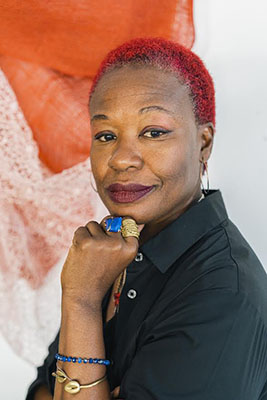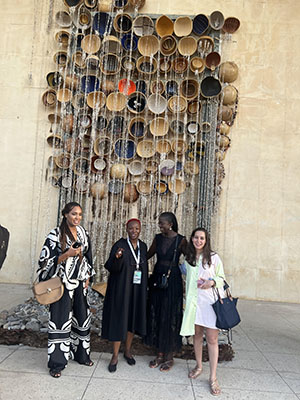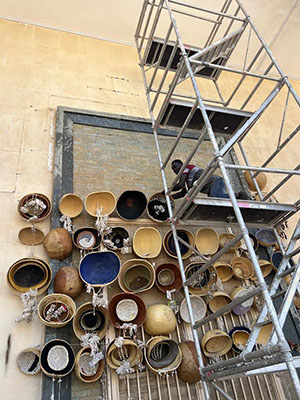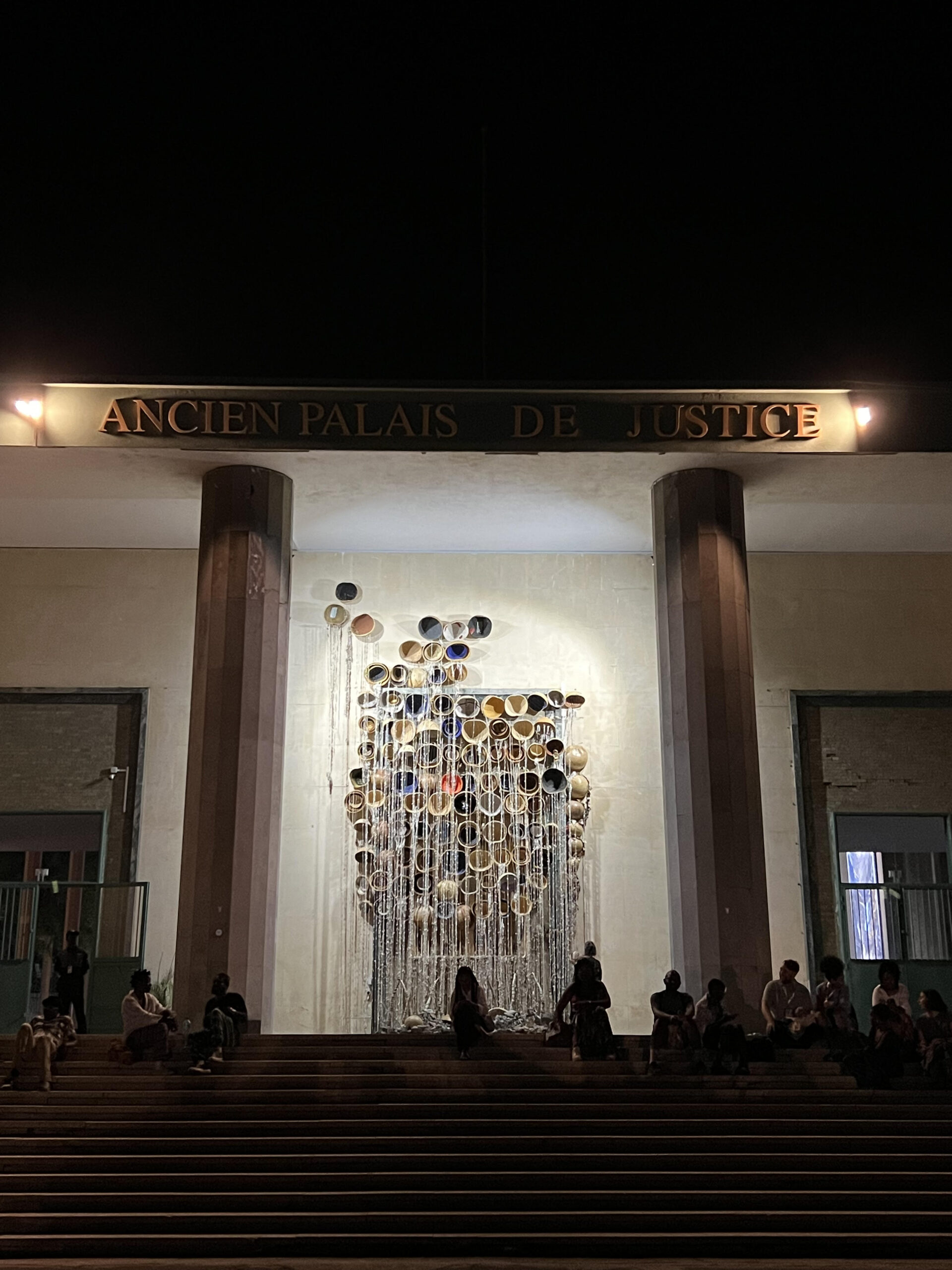Campus News
Creating enchantment in Senegal
UC Santa Cruz Humanities Professor Gina Athena Ulysse was invited to participate as a featured artist for the prestigious Dakar Biennale (Dak’Art), which the New York Times called “Africa’s hottest art event” and “Africa’s most prominent cultural gathering.”




UC Santa Cruz Humanities Professor Gina Athena Ulysse has traveled to Senegal to transform the facade of a sprawling Brutalist building into an enchanted portal adorned with cowry shells, woven tails of twine, and hundreds of calabashes painted in vibrant colors.
She was invited to participate as a featured artist for the prestigious Dakar Biennale (Dak’Art), which the New York Times called “Africa’s hottest art event” and “Africa’s most prominent cultural gathering.”
Ulysse, who was selected as the 57th Faculty Research Lecturer, is a prolific Haitian-American scholar and artist. She refers to her practice as rasanblaj– that is, the gathering of ideas, things, people and spirits. She is known for her written works as well as her performance lectures that incorporate history, narratives and statistics laced with Vodou chants and popular songs.
In the past, an estimated 250,000 people have attended this festival in Africa’s western tip. Ulysse was determined to create something immersive, memorable and beautiful that explores Haiti and Senegal’s shared colonial history.
This 15th Edition of the Biennale, under the artistic direction of Salimata Diop, is titled “The Wake,” L’eveil and Xall wi in Wolof. The Biennale runs from Nov. 7 to Dec. 7. Its 58 featured artists from Africa and across the African Diaspora will explore the relationship between art, society, climate, and history in particular. Ulysse is one of only three artists from the United States to be selected for this art event.
In another career milestone, Ulysse was also chosen to deliver the Biennale’s opening keynote address at the New Museum of Black Civilization in Dakar on November 8th. The previous Biennale keynote was delivered by Gayatri Chakravorty Spivak, a highly influential Indian scholar, literary theorist, and feminist critic.
Ulysse was also thrilled to learn that the Biennale committee saw that her installation was “in conversation” with the work of renowned Kenyan artist Wangechi Mutu, who is participating this year as the Grand Temoin. Mutu’s multimedia installation is in the main courtroom of the palace.
An enchanting installation: layers of color, texture, and meaning
Ulysse’s installation is textural and rich in dark indigos, oranges and reds. Calabashes, many in their natural form, spill open to reveal tight clusters of cowried twine. Part of the installation features calabashes attached to a wall and climbing almost to the rooftop of the Ancien Palais de Justice in Dakar, with skeins of strings hanging down from the gourds.
To achieve this effect, Ulysse had her materials sourced and different components fabricated ahead of time.
Ulysse hired Bay Area artist Evan Bissell as a senior consultant of practice to manage the project. During Ulysse’s initial site visit in February, an assistant in Dakar oversaw the making of over one thousand strings with 110 kilos of cowries by artisans and a collective.
Ulysse has exhibited her work internationally, including a site-specific installation at the 2020 Biennale of Sydney, Australia. However, her current installation, For Those Among Us Who Inherited Sacrifice, Rasanblaj, is her most ambitious to date.
She first envisioned this project during a Bogliasco Foundation residency in Italy. While there, in conversation with Salimata Diop, she mentioned wanting to create a “cascade of calabashes, with cowries as the water.”
Months later, she learned that her submitted proposal was selected by the Biennale Committee to be presented on the facade, a first for Dak’Art.
“I was so supported there that my imagination went wild in terms of scale,” Ulysse said, speaking from Senegal.
In this installation, using materials sourced in Senegal including the much loved Kenkeliba tea, Ulysse pays homage to Senegal’s connection to her native Haiti.
The work also includes reprints of archival ledgers that reference a dark part of Haitian history: when France in 1825, after the Haitian Revolution, forced the First Black Republic to pay enormous “indemnity” payments to former slave owners for “property loss,” a massive debt that hindered Haiti’s economy for decades.
Her installation is a powerful expression of creative resistance and determination in the face of oppression. It extends her scholarly work, exploring the intersections of ethnography, performance, physical and textual materials, and colonial history.
Despite these themes, Ulysse cautions against interpreting the work in a single, finite way. “This piece is for everyone,” she said. “I believe people can engage with it on a purely aesthetic level.”
A transformative experience in Dakar
The installation also reflects her deep connection to Senegal, a country with much in common with Haiti. “Both are former French colonies,” she noted. “Everywhere I go here, people are surprised that I’m Anglophone and speak French. I tell them, ‘I grew up in Haiti!’”
Unable to return to Haiti due to ongoing crises, Ulysse has found a new connection to Senegal, an overwhelmingly Muslim country. “There’s a calm here,” she observed. “I also feel really safe here.”
Her installation celebrates the enchantment of the natural world, treating calabashes—sacred in many African cultures—as living beings. “The enchantment lies in deep listening, arranging the objects in ways that feel right, thinking about form and composition, but not confined by strict meaning and remaining open to interpretation,” she said.
The installation’s creation was a deeply communal process. “Because of the large scale, I traveled earlier than the other artists so I had the opportunity to work with a group of eight students from the Ecole Nationale des Arts,” Ulysse said. “For several days, we did rasanblaj workshops, which began with braiding and conversations about their generational concerns and aspirations as folks on the African continent. I incorporated our culminating piece titled ‘La Queue (The Tail or the Youth)’ on the facade.”
“Our work together involved countless hours of preparing and re-assembling different components of the piece,” she said. “Additionally, the Biennale team of workers including fabricators and technicians of all kinds were instrumental to the installation phase.”
A labor of devotion and love
The high-profile nature of the event and the large audience it will draw make every effort worthwhile. “This is a labor of devotion and love,” Ulysse said.
When selected for this year’s 15th Biennale, Ulysse found the project’s scale exhiliarating and daunting. “I knew I had to show up, to research and learn about land-based practices,” she recalled.
Back in February, when she first saw the Biennale main site, she realized her work had to be monumental. “The ceiling is nearly 40 high,” she said. “They told me, ‘We’re giving you a stage. Take it over.’”
Political instability forced the postponement of the event, which was originally scheduled to run from May through June.
“I was there in Dakar when I got the official news,” Ulysse said. “I had folks who traveled just to work with me. We ended up using the time like a residency. The calabashes were sourced through an organic network.”
When Ulysse returned in the fall, she found renewed strength and joy with her team of assistants, who brought a sense of celebration. Even the palace security guards at the entrance played a part and offered helpful feedback, leading her to call one of them the work’s “guardian angel.”
Ever the ethnographer, she places the building of relationships with people and her intuitive connection with materials at the heart of her rasanblaj practice.
“The material tells me what to do,” Ulysse explained. “Sometimes, inspiration comes in a dream, then an idea forms, and the composition comes later. Often, I start with a title; it lures or directs me. This happens with my performances, articles, and essays.”
“Like Zora Neale Hurston and Katherine Dunham, my foremothers, I have been pushing the boundaries of anthropology into the arts,” she continued. “I insist on it.”
This Biennale has been transformative for Ulysse.
“Being here is making me so happy,” she said. “I can’t wait to teach a course at UC Santa Cruz based on my experience in Dakar, and I can’t wait to see what I produce next. I am no longer afraid of scale.”
The work was funded in part by The Humanities Institute, the Humanities Division, and the Art Research Institute.